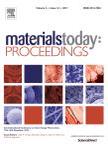版权所有:内蒙古大学图书馆 技术提供:维普资讯• 智图
内蒙古自治区呼和浩特市赛罕区大学西街235号 邮编: 010021

作者机构:Faculty of Chemical and Process Engineering Technology Lebuh Persiaran Tun Khalil Yaakob 26300 Kuantan Pahang Malaysia Experimental and Theoretical Research Laboratory Department of Chemistry Kulliyyah of Science International Islamic University Malaysia 25200 Kuantan Pahang Malaysia
出 版 物:《Materials Today: Proceedings》 (Mater. Today Proc.)
年 卷 期:2023年
核心收录:
学科分类:0830[工学-环境科学与工程(可授工学、理学、农学学位)] 0817[工学-化学工程与技术] 08[工学] 0805[工学-材料科学与工程(可授工学、理学学位)] 080502[工学-材料学] 0703[理学-化学] 0702[理学-物理学]
主 题:Blending
摘 要:Biobased polymer nanocomposites are a separate class of materials created by the inclusion of nanoparticles into polymer matrix composites. In comparison to ordinary composites, these materials have superior mechanical, electrical, thermal, and barrier characteristics, as well as exceptional microstructures, which have attracted global interest. For toughness modification, poly(lactic acid) (PLA) is commonly toughened with low-modulus polymers such as linear low-density polyethylene (LLDPE). Due to environmental concerns, recycled tire waste (RW) was included in a binary blend of PLA and LLDPE and reinforced with graphene nanoplatelets (GNP). The polymer resins, RW and GNP were melt blended in a twin-screw extruder at 60 rpm for 15 min. The blends were then characterized for chemical changes, thermal transitions and thermal degradation. Due to the presence of platelets, it was discovered that the 40/50/10/5 (PLA/LLDPE/RW/GNP) nanocomposite exhibited the maximum thermal degradation temperature. Thermal transitions were observed in all nanocomposites without any appreciable chemical changes. © 2023 Elsevier Ltd. All rights reserved.